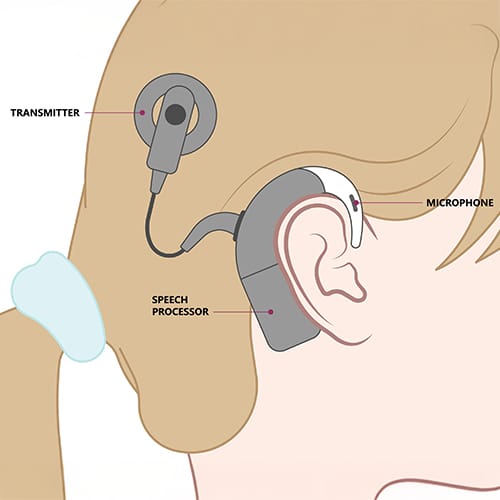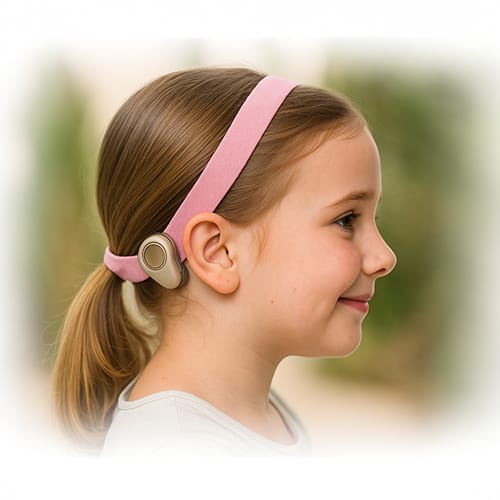Bone Conduction Devices
Bone conduction devices offer a direct, effective way to hear by bypassing the outer and middle ear. Whether you need a surgical BAHA or a non-invasive BCHA, find the right solution for your hearing needs. Bone conduction devices offer a direct, effective way to hear by bypassing the outer and middle ear. Whether you need a surgical BAHA or a non-invasive BCHA, find the right solution for your hearing needs.


Bone-Anchored Hearing Aids (BAHA)
A BAHA is a surgically implanted hearing solution designed for individuals who experience significant hearing loss that cannot be effectively managed with conventional hearing aids.
- A sound processor captures and converts sound waves into vibrations.
- These vibrations are transferred through a titanium implant placed in the skull.
- The inner ear (cochlea) processes the vibrations as sound, providing clear auditory perception.
- Individuals with conductive or mixed hearing loss.
- People with single-sided deafness (SSD).
- Those who experience chronic ear infection or have anatomical ear canal issues.
- Delivers clear and natural sound quality.
- Long-term stable hearing solution.
- Requires surgical implantation.
- Involves ongoing maintenance of the processor.
Bone Conduction Hearing Aids (BCHA)
A BCHA is a non-surgical alternative that provides hearing support through vibrations transmitted via a headband or adhesive pad.
- A sound processor captures and converts sound into vibrations.
- The device sits externally and transmits sound waves through the skin and bone to reach the inner ear.
- Individuals with temporary conductive hearing loss.
- Children who are not yet eligible for surgery.
- Individuals seeking a non-invasive hearing solution.
- No surgery needed – ideal for temporary or mild cases.
- Affordable and accessible hearing support.
- May feel less stable compared to implantable options.
- Can cause discomfort with prolonged use.

Which Hearing Solution is Right for You?
Deciding between BAHA and BCHA depends on the severity of hearing loss, medical eligibility, and personal preference. Consulting an audiologist or ENT specialist is essential for figuring out the best choice.
| Feature | BAHA (Implantable) | BCHA (Non-Implantable) |
| Procedure | Surgical implant | External, no surgery |
| Best For | Long-term hearing loss | Temporary or mild cases |
| Comfort | Stable, discreet | May require adjustments |
| Maintenance | Periodic care of the processor | Replaceable parts |
Book a Consultation Today
If you’re experiencing hearing difficulties, contact Hear4U to explore the best bone conduction solution for you. Our team of specialists can guide you through your options and help restore clarity to your hearing.
Frequently Asked Questions
What is a Bone Conduction Hearing Aid and how does it work?
A Bone Conduction Hearing Aid (BCHA) transmits sound through vibrations in the skull, bypassing the outer and middle ear to reach the inner ear. This technology is ideal for individuals with conductive hearing loss, single-sided deafness (SSD), or mixed hearing loss who struggle with traditional hearing aids.
Who is a good candidate for a Bone Conduction Hearing Device?
- Bone conduction devices are ideal for people with:
- Conductive hearing loss (caused by outer/middle ear issues)
- Mixed hearing loss (a combination of conductive and sensorineural loss)
- Single-sided deafness (SSD)
- Chronic ear infections that make traditional hearing aids uncomfortable
Is a Bone-Anchored Hearing Aid (BAHA) better than traditional hearing aids?
A BAHA hearing aid is better suited for individuals who cannot benefit from traditional in-ear or behind-the-ear hearing aids. Since it delivers sound via bone conduction, it bypasses damaged ear structures, resulting in clearer, more natural hearing for the right candidates.
Is BAHA surgery safe and what is the recovery time?
Yes, BAHA surgery is a safe and minimally invasive procedure. It typically takes 1-2 hours, and recovery time is around 4-6 weeks for the implant to fully integrate with the bone. Patients usually experience minimal discomfort and can return to daily activities within a few days.
Can children use Bone Conduction Hearing Aids?
Yes! Children with hearing loss who are not ready for BAHA surgery can receive help from a Bone Conduction Hearing Aid (BCHA), which provides a non-invasive hearing solution using a headband or adhesive attachment.
Does the NHS cover Bone Conduction Hearing Aids?
In the UK, BAHA devices are available on the NHS for eligible patients who meet the clinical criteria. However, private options are also available for faster access to treatment. Check with your audiologist or ENT specialist for more details.
How long does a BAHA device last?
The BAHA implant is designed to last a lifetime, while the external sound processor may need to be replaced or upgraded every 5-7 years, depending on wear and technological advancements.
How do I get started with a Bone Conduction Hearing Solution?
The first step is to book a hearing consultation with a specialist. At Hear4U, we assess your hearing needs and help you choose the right solution—whether it’s a non-surgical BCHA or a permanent BAHA implant.





